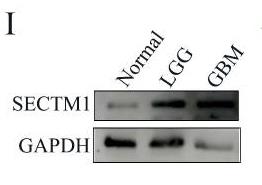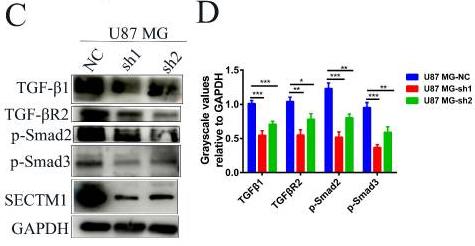SECTM1
-
Official Full Name
secreted and transmembrane 1 -
Overview
This gene encodes a transmembrane and secreted protein with characteristics of a type 1a transmembrane protein. It is found in a perinuclear Golgi-like pattern and thought to be involved in hematopoietic and/or immune system processes. -
Synonyms
SECTM1;secreted and transmembrane 1;secreted and transmembrane protein 1;K12;K12 protein;type 1a transmembrane protein;Protein K-12;Protein K12;SCTM1_HUMAN;SECTM 1
Recombinant Proteins
- Human
- E.coli
- Wheat Germ
- HEK293
- Human Cells
- In Vitro Cell Free System
- Mammalian Cells
- His
- Non
- Fc
- GST
| Cat.# | Product name | Source (Host) | Species | Tag | Protein Length | Price |
|---|---|---|---|---|---|---|
| SECTM1-2571H | Recombinant Human SECTM1, His-tagged | E.coli | Human | His | 29-248aa | |
| SECTM1-31348TH | Recombinant Human SECTM1 | Wheat Germ | Human | Non | 220 amino acids |
|
| SECTM1-3967H | Recombinant Human SECTM1 protein, His-tagged | HEK293 | Human | His | Gln29-Gly145 |
|
| SECTM1-1946HCL | Recombinant Human SECTM1 cell lysate | Human Cells | Human | Non |
|
|
| SECTM1-1273H | Active Recombinant Human SECTM1 protein, hFc&His-tagged | HEK293 | Human | Fc&His | Gln29-Gly145 |
|
| SECTM1-1947H | Recombinant Human SECTM1 protein, His & GST-tagged | E.coli | Human | GST&His | Gln29~Pro248 |
|
| SECTM1-438H | Recombinant Human SECTM1 Protein, His-tagged | HEK293 | Human | His | 248 |
|
| SECTM1-4550H | Recombinant Human SECTM1 protein, hFc-tagged | HEK293 | Human | Fc | Gln29-Gly145 |
|
| SECTM1-460HF | Recombinant Full Length Human SECTM1 Protein | In Vitro Cell Free System | Human | Full L. 220 amino acids |
|
|
| SECTM1-6258H | Recombinant Human SECTM1 Protein (Gln29-Gly145), C-His tagged | Mammalian Cells | Human | His | Gln29-Gly145 |
|
Background
What is SECTM1 Protein?
SECTM1 (Secreted and Transmembrane 1) is a protein that works both as a membrane-bound and secreted form, known for its Type 1a transmembrane characteristics. You'll find SECTM1 in different tissues and cells, such as white blood cells, lymphocytes, monocytes, liver cells, and bone marrow cells. It plays a key part in immune regulation by interacting with receptors on these immune cells, affecting how they signal, behave, and function. It's involved in managing inflammatory responses, promoting apoptosis, and contributing to tumor immune evasion. Its interaction with CD7 suggests a role in thymocyte signaling and immune response regulation. In cancer research, SECTM1 expression in colorectal cancer is linked to processes like cell proliferation, apoptosis, cell cycle, and invasion.What is the Function of SECTM1 Protein?
SECTM1 protein plays a key role in various biological processes, primarily involving immune regulation and tumor development. As a ligand for CD7, SECTM1 binds to CD7 on T-cells and natural killer (NK) cells, helping these immune cells grow and activate. This is crucial for the immune system, especially in fighting tumors. SECTM1 is highly expressed in several cancers, like melanoma, breast, and prostate cancer, possibly affecting tumor-associated macrophages in the tumor environment. In melanoma, SECTM1 attracts monocytes through the CD7-mediated PI3K pathway, influencing tumor progression. Thus, SECTM1 is significant not only in immune regulation but also as a potential target for cancer therapy.SECTM1 Related Signaling Pathway
SECTM1 protein takes part in several signaling pathways related to immune regulation and tumor growth. It binds with CD7 to activate the PI3K pathway, promoting monocyte movement and cancer cell invasion. SECTM1 also influences glioblastoma cell growth and movement by modulating the TGF-β1/Smad pathway. In the immune response, it's an early response gene for IFN-γ, aiding in immune cell activation and proliferation. These actions make SECTM1 significant in the tumor environment and immune responses.SECTM1 Related Diseases
SECTM1 protein is connected to several diseases, with a significant impact on cancer. Studies indicate that SECTM1 is present at high levels in colorectal cancer and is involved in tumor growth, cell death, cell cycle, and invasion. In glioblastoma, SECTM1 is also highly expressed, promoting tumor cell growth and movement by affecting the TGF-β1/Smad pathway. These insights suggest SECTM1 might serve as a diagnostic marker or a treatment target for different cancers.Bioapplications of SECTM1
SECTM1 protein has a variety of uses in research, industry, and clinical studies. In research, SECTM1 is crucial for studying immune regulation and cancer development, especially in how it's expressed and functions in cancers like colorectal cancer and glioblastoma. Its recombinant protein is used in labs as a positive control and immunogen to aid related studies. In industry, SECTM1's recombinant protein can be efficiently produced using hosts like E. coli for creating lab reagents. Clinically, SECTM1 is considered a potential biomarker for the immune response in cancer therapies, with its expression level in tumors linked to treatment outcomes. These applications open new avenues for cancer diagnosis and treatment.Case Study
Case Study 1: Wang T. et al. J Invest Dermatol. 2014
Researchers discovered that tumor-associated macrophages (TAMs) play crucial roles in how tumors grow and spread. Tumors recruit myeloid progenitors and monocytes, turning them into TAMs, though this isn't well understood in humans. They found that human CD7, typically a marker for T-cells and NK cells, is also present in monocytes and macrophages. CD7 levels drop when these cells become macrophages with M-CSF or melanoma-conditioned medium. SECTM1, which binds to CD7, is common in many tumors like melanoma, and boosts monocyte movement through the PI3K pathway. In melanoma samples, macrophages with CD7 are present within tumors. Those cancers often show high SECTM1 levels, including a soluble form found in the blood of patients with metastatic melanoma but not in healthy people. Based on their findings, CD7 on these immune cells, combined with SECTM1 in melanoma, might guide monocytes and change the tumor environment.-
 Fig1. Expression of SECTM1 analyzed by flow cytometry.
Fig1. Expression of SECTM1 analyzed by flow cytometry. -
 Fig2. SECTM1 increases monocyte migration in a transwell assay.
Fig2. SECTM1 increases monocyte migration in a transwell assay.
Case Study 2: Yao Z. et al. Int J Biol Sci. 2024
Secreted and transmembrane protein 1 (SECTM1) encodes a transmembrane protein, but its role in glioblastoma (GBM) is not well understood. Researchers first reported abnormal SECTM1 expression in GBM and explored its role in the cancer. They used qRT-PCR, Western blotting, and immunofluorescence to check SECTM1 levels in various glioma grades and GBM cell lines. Using shRNA to knock down SECTM1, they tested its impact on GBM cells through CCK-8, Transwell, EdU, and wound healing assays. They looked into SECTM1's effects on GBM in vitro and in vivo, using subcutaneous tumor xenografts in mice to see how SECTM1 influences glioma growth. Results showed that reducing SECTM1 expression in cell lines notably slowed GBM cell proliferation, migration, and invasion and stopped xenograft tumor growth in mice. Although SECTM1's exact role in GBM isn't fully clear, it appears to promote epithelial-mesenchymal transition (EMT)-like processes. Bioinformatics and Western blotting suggest SECTM1 mainly drives glioblastoma invasion and EMT through the TGFβ1/Smad pathway.-
 Fig3. Western blot to detect the relative expression difference of SECTM1 in normal brain tissue.
Fig3. Western blot to detect the relative expression difference of SECTM1 in normal brain tissue. -
 Fig4. Western blotting showed the changes of downstream genes of TGF-β1/Smad pathway after SECTM1 knockdown in U87 MG cells.
Fig4. Western blotting showed the changes of downstream genes of TGF-β1/Smad pathway after SECTM1 knockdown in U87 MG cells.
Quality Guarantee
High Purity
-
.jpg) Fig1. SDS-PAGE (SECTM1-3967H)
Fig1. SDS-PAGE (SECTM1-3967H) -
.jpg) Fig2. SDS-PAGE (SECTM1-1273H)
Fig2. SDS-PAGE (SECTM1-1273H)
Involved Pathway
SECTM1 involved in several pathways and played different roles in them. We selected most pathways SECTM1 participated on our site, such as , which may be useful for your reference. Also, other proteins which involved in the same pathway with SECTM1 were listed below. Creative BioMart supplied nearly all the proteins listed, you can search them on our site.
| Pathway Name | Pathway Related Protein |
|---|
Protein Function
SECTM1 has several biochemical functions, for example, cytokine activity,signal transducer activity. Some of the functions are cooperated with other proteins, some of the functions could acted by SECTM1 itself. We selected most functions SECTM1 had, and list some proteins which have the same functions with SECTM1. You can find most of the proteins on our site.
| Function | Related Protein |
|---|---|
| cytokine activity | GM13287,TNFSF11,CCL6,NDR1,IFNPHI4,IL18,CTF1,TNFSF9,NODAL,IFNE |
| signal transducer activity | GPR89,MRGPRA5,MRGPRA7,FPR3,GPR124,OLFR147,GNAQ,CXCR2,PLCL2,HTR5AL |
Interacting Protein
SECTM1 has direct interactions with proteins and molecules. Those interactions were detected by several methods such as yeast two hybrid, co-IP, pull-down and so on. We selected proteins and molecules interacted with SECTM1 here. Most of them are supplied by our site. Hope this information will be useful for your research of SECTM1.
Y0062
Resources
Research Area
Related Services
Related Products
References



